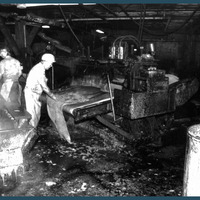-
Title
-
Howes Leather in Frank, Pocahontas County, WV.
-
Caption
-
In addition to more efficient logging technologies, wood-byproduct industries—like paper and leather production—boosted profits for timber companies and hastened the depletion of forest resources.
Commercial logging operations sold chestnut, oak, and hemlock bark to tanneries, which needed this tannin-rich byproduct to make leather. As industrialized logging made tree bark more available, the tanning of animal hides—once a small-scale trade in Appalachia—transitioned to a commercial industry.
Although it reduced logging waste by providing a use for bark, leather tanning produced pollutants that contaminated nearby waterways. Additionally, the demand for tannins further incentivized the destruction of chestnut trees, even after a deadly blight began wiping them out.
-
Howes Leather in Frank, Pocahontas County, was once the largest producer of shoe sole leather in the world, but synthetic materials and foreign competition eventually led to its shutdown and the decline of the mountain tanning industry.
 Howe_s Tannery1.tif
Howe_s Tannery1.tif